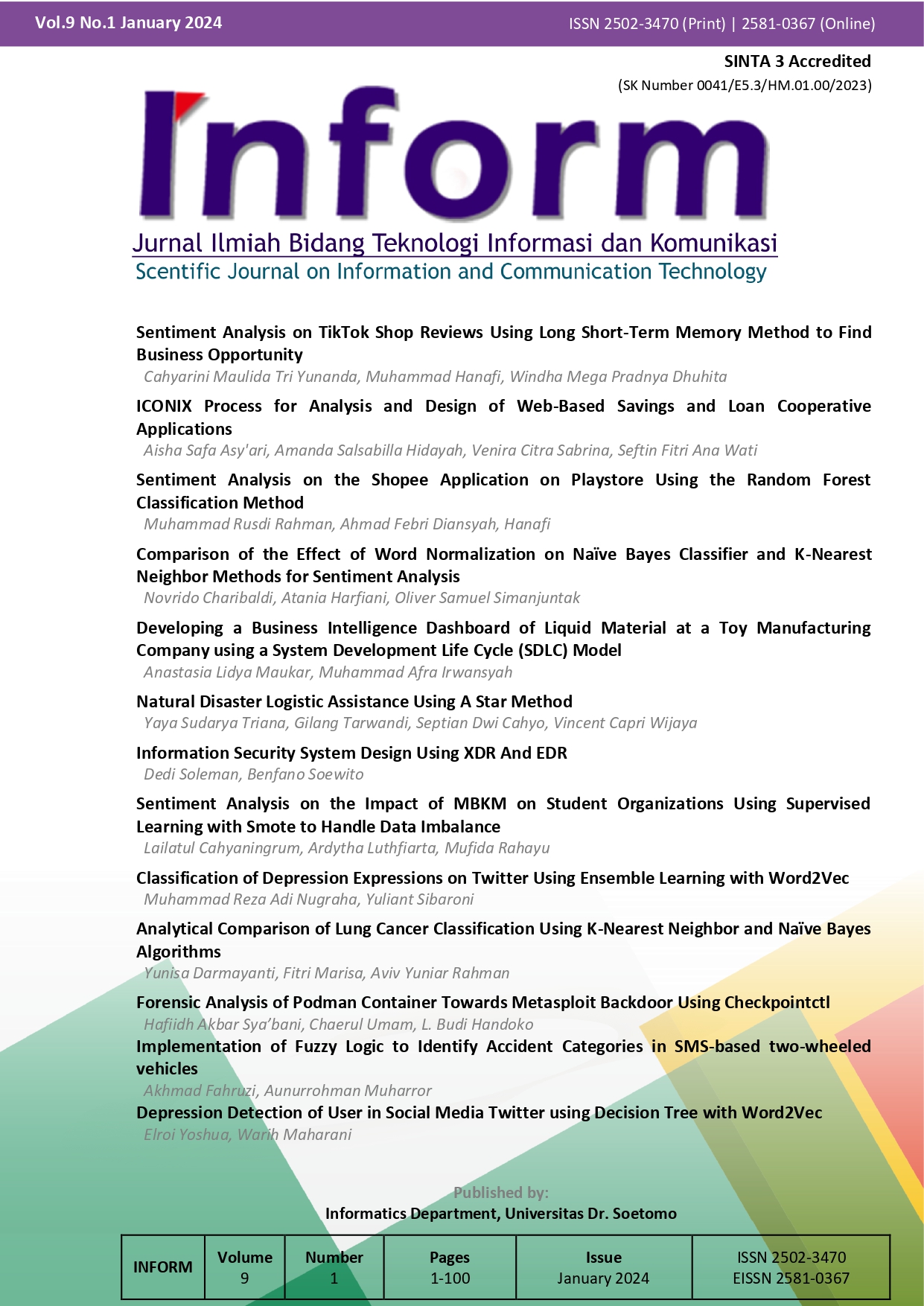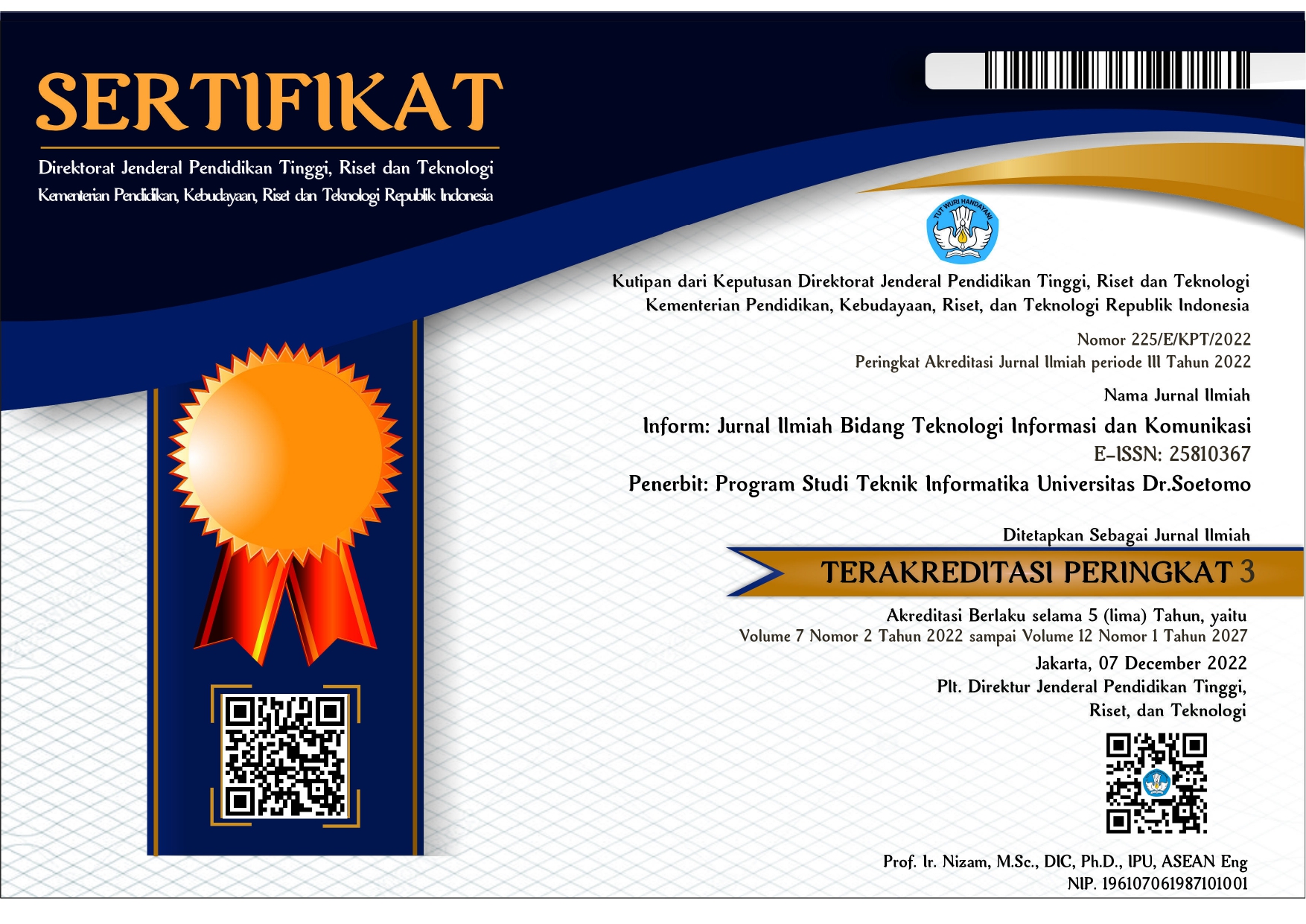Classification of Depression Expressions on Twitter Using Ensemble Learning with Word2Vec
 Abstract views: 413
,
Abstract views: 413
,
 PDF downloads: 304
PDF downloads: 304
Abstract
One of the mental health disorders experienced by people is depression. Depression is a mental disorder characterized by feelings of sadness, loss of interest or pleasure in daily activities, and decreased cognitive function that can affect social life, work, and general physical health. Early detection is needed to prevent the occurrence of bad risks. One of the early detections can be done through social media. This is because social media is one of the tools used to channel expression. This research uses data taken from Twitter social media to create a machine learning model. Before model building, data pre-processing will be carried out using Word2Vec to convert text into a continuous vector representation. The algorithm used is ensemble learning by combining five algorithms: Logistic Regression, Decision Tree, K-Nearest Neighbor, Artificial Neural Network, and Support Vector Machine. The results show that different Word2Vec architectures can give the model another performance. Ensemble Learning can improve the performance of using a single model. The best results were obtained by using a data ratio of 90:10 using the Skip-gram architecture to get an accuracy value and f1-score of 94%.
References
H. Jalonen, "Negative Emotions in Social Media as a Managerial Challenge," Proc. 10Th Eur. Conf. Manag. Leadersh. Gov. (Ecmlg 2014), pp. 128–135, 2014.
P. Tong et al., "Clinical traits of patients with major depressive disorder with comorbid borderline personality disorder based on propensity score matching," Depress. Anxiety, vol. 38, no. 1, pp. 100–106, 2021, doi: 10.1002/da.23122.
Y. M. Alsagri HS, "Machine Learning-Based Approach for Depression Detection in Twitter Using Content and Activity Features," IEICE Trans. Inf. Syst., vol. E103-D, 2020, doi: 10.1587/transinf.2020EDP7023.
F. Ilham and W. Maharani, "Analyze Detection Depression In Social Media Twitter Using Bidirectional Encoder Representations from Transformers," J. Inf. Syst. Res., vol. 3, no. 4, pp. 476–482, 2022, doi: 10.47065/josh.v3i4.1885.
T. T. H. Le, H. Kang, and H. Kim, "Household appliance classification using lower odd-numbered harmonics and the bagging decision tree," IEEE Access, vol. 8, pp. 55937–55952, 2020, doi: 10.1109/ACCESS.2020.2981969.
A. S. Assiri, S. Nazir, and S. A. Velastin, "Breast Tumor Classification Using an Ensemble Machine Learning Method," J. Imaging, vol. 6, no. 6, 2020, doi: 10.3390/JIMAGING6060039.
A. Bastian, Ardi Mardiana, and Dinda Sri Wulansari, “Sentiment Analysis Against Political Figure’s Billboard During Pandemic Using Naïve Bayes Algorithm,†J. RESTI (Rekayasa Sist. dan Teknol. Informasi), vol. 7, no. 1, pp. 138–145, 2023, doi: 10.29207/resti.v7i1.4643.
N. Bilgel and N. Bayram, “Depresyon anksiyete stres ölçeǧinin (DASS-42) Türkçeye uyarlanmiş şeklinin psikometrik özellikleri,†Noropsikiyatri Ars., vol. 47, no. 2, pp. 118–126, 2010, doi: 10.4274/npa.5344.
F. K. Khattak, S. Jeblee, C. Pou-Prom, M. Abdalla, C. Meaney, and F. Rudzicz, "A survey of word embeddings for clinical text," J. Biomed. Informatics X, vol. 4, no. October, p. 100057, 2019, doi: 10.1016/j.yjbinx.2019.100057.
S. Sivakumar, L. S. Videla, T. Rajesh Kumar, J. Nagaraj, S. Itnal, and D. Haritha, "Review on Word2Vec Word Embedding Neural Net," Proc. - Int. Conf. Smart Electron. Commun. ICOSEC 2020, no. Icosec, pp. 282–290, 2020, doi: 10.1109/ICOSEC49089.2020.9215319.
S. Tangirala, "Evaluating the impact of GINI index and information gain on classification using decision tree classifier algorithm," Int. J. Adv. Comput. Sci. Appl., vol. 11, no. 2, pp. 612–619, 2020, doi: 10.14569/ijacsa.2020.0110277.
Y.-S. . Loh, W.-Y., and Shih, "Split selection methods for classification trees," Stat. Sin., pp. 815-840., 1997.
M. P. LaValley, "Logistic regression," Circulation, vol. 117, no. 18, pp. 2395–2399, 2008, doi: 10.1161/CIRCULATIONAHA.106.682658.
K. Taunk, "A Brief Review of Nearest Neighbor Algorithm for Learning and Classification," 2019 Int. Conf. Intell. Comput. Control Syst. ICCS 2019, no. Iciccs, pp. 1255–1260, 2019.
K. Kar, S. Kornblith, and E. Fedorenko, "Interpretability of artificial neural network models in artificial intelligence versus neuroscience," Nat. Mach. Intell., vol. 4, no. 12, pp. 1065–1067, 2022, doi: 10.1038/s42256-022-00592-3.
Muhammad Afif Raihan and Erwin Budi Setiawan, "Aspect Based Sentiment Analysis with FastText Feature Expansion and Support Vector Machine Method on Twitter," J. RESTI (Rekayasa Sist. dan Teknol. Informasi), vol. 6, no. 4, pp. 591–598, 2022, doi: 10.29207/resti.v6i4.4187.
A. Chauhan, A. Agarwal, and R. Sulthana, "Genetic Algorithm and Ensemble Learning Aided Text Classification using Support Vector Machines," Int. J. Adv. Comput. Sci. Appl., vol. 12, no. 8, pp. 260–267, 2021, doi: 10.14569/IJACSA.2021.0120830.
L. Wen and M. Hughes, "Coastal wetland mapping using ensemble learning algorithms: A comparative study of bagging, boosting and stacking techniques," Remote Sens., vol. 12, no. 10, 2020, doi: 10.3390/rs12101683.
R. S. Khairy, A. S. Hussein, and H. T. H. S. ALRikabi, "The Detection of Counterfeit Banknotes Using Ensemble Learning Techniques of AdaBoost and Voting," Int. J. Intell. Eng. Syst., vol. 14, no. 1, pp. 326–339, 2021, doi: 10.22266/IJIES2021.0228.31.
S. Haghighi, M. Jasemi, S. Hessabi, and A. Zolanvari, "PyCM: Multiclass confusion matrix library in Python," J. Open Source Softw., vol. 3, no. 25, p. 729, 2018, doi: 10.21105/joss.00729.
A. Luque, A. Carrasco, A. MartÃn, and A. de las Heras, "The impact of class imbalance in classification performance metrics based on the binary confusion matrix," Pattern Recognit., vol. 91, pp. 216–231, 2019, doi: 10.1016/j.patcog.2019.02.023.
R. M. and S. Meena, "Empirical Validation of cross-version and 10-fold cross-validation for Defect Prediction," 2021 Second Int. Conf. Electron. Sustain. Commun. Syst., 2021, doi: 10.1109/ICESC51422.2021.9533030.
Copyright (c) 2024 Muhammad Reza Adi Nugraha, Yuliant Sibaroni

This work is licensed under a Creative Commons Attribution-ShareAlike 4.0 International License.
Authors who publish with Inform: Jurnal Ilmiah Bidang Teknologi Informasi dan Komunikasi agree to the following terms:
-
Authors retain copyright and grant the journal right of first publication with the work simultaneously licensed under a Creative Commons Attribution License (CC BY-SA 4.0) that allows others to share the work with an acknowledgment of the work's authorship and initial publication in this journal.
-
Authors are able to enter into separate, additional contractual arrangements for the non-exclusive distribution of the journal's published version of the work (e.g., post it to an institutional repository or publish it in a book), with an acknowledgment of its initial publication in this journal.
-
Authors are permitted and encouraged to post their work online (e.g., in institutional repositories or on their website) prior to and during the submission process, as it can lead to productive exchanges, as well as earlier and greater citation of published work.













